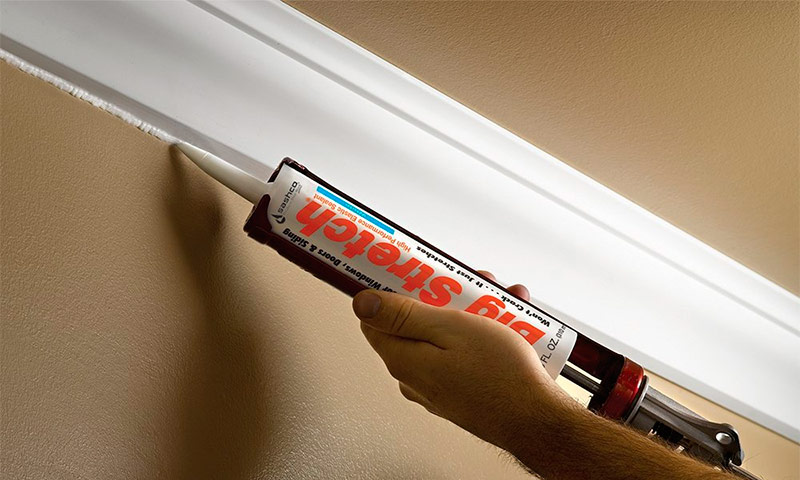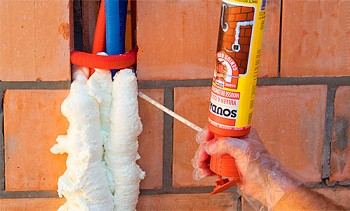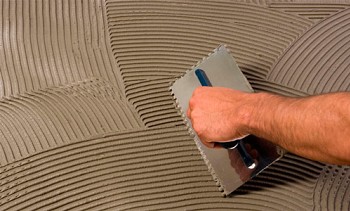Sealants used in construction are materials with the help of which they eliminate all kinds of cracks and cracks. When filling voids with sealing compounds made on the basis of polymers, a dense layer is formed with a certain degree of elasticity. From this article you will learn about the properties that each joint sealant is endowed with, and you will also receive all the necessary information regarding the choice of material, based on the type of work performed.

Content:
Varieties of building sealants
The chemical composition of any sealant contains the main component, as well as special additives. To date, there are several base classes of such materials.
Silicone sealants
Silicone is used as the main active substance, the content of which is at least 45%. The layer applied to the surface maintains high elasticity even after final drying. The sealant has excellent adhesion properties to a wide variety of materials, including ceramics, glass, non-oxidizing alloys. It is characterized by increased moisture resistance, due to which it can be used during plumbing.
With the help of such compositions, almost any seams and joints can be qualitatively sealed. Since applying paint to silicone is not possible, in addition to transparent sealants, the production of painted materials with all kinds of shades was established.
Today, the following types of silicone compounds are available:
General Purpose Sealantsin the manufacture of which silicone rubber is used together with a hydrophobic filler. Both components are contained in almost equal proportions.
Sanitary Sealant, the chemical composition of which includes special antifungal additives that prevent the formation of mold. This material is recommended for use in bathrooms and other rooms with high humidity.
Sealant for aquariums, the state of which in the hardened form cannot be affected by the negative conditions of the biological environment. At the same time, the composition itself is absolutely safe from an environmental point of view.
Window sealant, in which there are additives that ensure its maximum resistance to UV rays. In addition, individual components interfere with the development of fungus and the formation of mold.

Acrylic Sealants
This type of sealant is based on acrylic resins, which do not have a high degree of elasticity, which does not allow them to be used to fill voids in places of possible deformation of structural elements. However, when applied to a wooden surface, as well as concrete, brick or plaster, the material shows good adhesion.
In conditions of low ambient temperature, the sealing substance loses its properties, therefore it is recommended to use it exclusively for internal work. Acrylic paint can be applied to the dried layer of the sealant used for joints, selected in accordance with the color of the surface.
Regardless of the distinguishing characteristics of the degree of moisture resistance of such materials, constant contact with water is contraindicated.

Acrylic silicone
In this case, the low moisture resistance, as the main disadvantage of acrylic compositions, was eliminated by adding silicone.As a result, it turned out to create a combined material that combines the properties of two components.
The material is not afraid of high humidity and temperature extremes, which allows it to be used for outdoor applications. In this case, the sealant is sufficiently resistant to deformation, and the seam formed after its application is obtained as elastic as possible.
Such formulations are ideally suited to provide density when minor voids are formed in doorways. Also, they can close up the seams that are in the window frames, on the plastered surfaces, between the elements of the facing tile or siding. It is allowed to stain dried material using oil or latex types of paints.

Polyurethane Sealants
Sealants of this type have fairly high strength and elasticity indicators. Compositions based on polyurethane are suitable for almost any job, because their adhesive properties guarantee reliable adhesion to concrete, ceramics, wood, metal and plastic products. At the same time, the material has increased resistance to moisture, and is also able to withstand significant mechanical loads. Its use in aggressive environments with weak acids and alkalis is allowed.
Polyurethane sealant can only be stored in airtight packaging. Otherwise, upon contact with air, its properties will be quickly lost. When using the material in a room, safety requirements must be observed, since toxins are released during its prolonged drying. The finally hardened seam can be painted with any paintwork.

Bitumen sealants
Such sealing substances are mainly used for roof repairs. The basis of the material is bitumen, which is present in combination with rubber. Demonstrates excellent adhesion to various materials, due to which it can be used to eliminate joints not only in the roofing, but also in the foundation or drainage system.
Such types of sealants for joints and cracks are able to withstand all kinds of atmospheric phenomena. They do not deform under the influence of moisture and are not afraid of frost. However, the application of the composition to the surface and its drying is allowed only in conditions of plus temperature.
The well-defined bitumen sealant has the following properties:
- high adhesion to roofing material, asbestos-cement slate, galvanized metal coatings and other types of roofing materials;
- ability to withstand the damaging effects of UV rays;
- absolute resistance to sharp temperature extremes;
- quick setting - from the moment of application to the final hardening no more than 4 hours pass;
- prevention of corrosion processes in places where there are metal structural elements.

Rubber Sealants
Sealants of this type are highly specialized building materials. They are mainly used for waterproofing in the processing of facade elements or roofing. It is allowed to use such a composition in a room with high humidity.
The distinctive properties of rubber-based sealants are:
- high adhesion to almost any type of surface. In this case, a sufficiently reliable coupling with a previously unprepared element is possible;
- resistance to various external influences, including mechanical, which can lead to deformation of the seam. This makes it possible to apply the material to complex areas of external structures;
- increased moisture resistance, due to which such a sealant is in demand among boat owners, since its constant contact with water is allowed;
- excellent compatibility of rubber with bitumen, which allows the use of the material in the process of roofing.

Rules for choosing a sealant for sealing joints and joints
Before choosing a sealant that will maximally correspond to the tasks, it is necessary to take into account some points.
Application area
The level of adhesion depends both on the characteristics of the sealing substance and on the surface on which it is intended to be applied. Therefore, it is necessary to find out for which surfaces you can apply the sealant of your choice. In addition, it is imperative to consider suitable sealant for indoor or outdoor use. The use of sealant intended for indoor use, on the street, will lead to its rapid destruction. You should also pay attention to the moisture indicators at the place of application of the sealant.
When filling voids that are below the water level, it is necessary to choose products designed for such conditions, which must be indicated in the annotation. If it is assumed to seal the aquarium, in this case, not only the height of the water column, but also the total volume of the operated tank is of importance. Despite the fact that most modern sealants are quite capable of withstanding heavy atmospheric precipitation, exclusively specialized materials can be in a constant environment of water.

Application temperature
In cases when external construction and repair work is carried out in the winter, the use of sealing substances is allowed, the properties of which are not affected by subzero temperatures. In addition, such conditions imply the application of the composition to a wet or frozen surface. The characteristics of the selected material should indicate this aspect.
terms of Use
For the finished joint, the temperature range within which the dried sealant is used is of great importance. Regarding formulations intended for external use, this indicator ranges from -35 to +80 degrees, which is quite acceptable for most Russian regions. In some cases, it is possible to use special materials with an acceptable temperature range from -60 to +200 degrees.
In addition, the degree of mobility of the seam must be taken into account. To fill the joints available in roofing, as well as overall metal structures, it is recommended to choose a sealing substance that has increased elasticity and is not prone to deformation.
Sealant color
Today, mainly white and transparent materials are produced. However, often on sale you can find gray, black or brown compounds. If the expected color of the joint does not combine with the basic shade of the surface, it makes sense to choose a painted sealant. On materials made on the basis of acrylic or acrylic silicone, oil or latex paints may well be applied.

Material consumption depending on the amount of work
In order to ensure that it is guaranteed enough during the application of the sealant, it is necessary to proceed from the number and depth of the voids that need to be filled. At the same time, the thickness of the applied layer can be reduced with the help of a special sealing material, which is placed inside the gap.

With a relatively small amount of work, it will be rational to purchase sealant in tubes. For processing a large area, it is more convenient to use material produced in tubes, which suggests the presence of a gun.
Manufacturer
Currently, the most popular brands are Moment, Titan, Cerezit, as well as Bison. However, the market also offers a large number of products of little-known firms. Moreover, the cost range is quite wide.As for branded materials, which, undoubtedly, are of high quality, their price often often includes a big name, as a result of which the consumer inevitably overpays.
In cases with products presented by an unknown manufacturer, you can significantly save, but there is an increased risk of receiving a product that does not meet the declared characteristics. It should be noted that in most cases it is practically impossible to find any fundamental difference between such materials.
Date of manufacture and expiration date
Regardless of the application, it is recommended to use only fresh sealant. When buying a tube or tube, you should pay attention to the date of manufacture of the material, which, together with the indicated expiration date, must be present directly on the case. In this case, the method of its application is of great importance - the numbers must be written in indelible paint or squeezed out.
Sometimes you can find on sale products with the date and time on a glued paper sticker. This is a reason to seriously doubt the freshness of the goods offered by the seller.
Tools and tools for working with sealant
The use of a sealing substance implies the presence of certain devices and auxiliary means.
Guns
There are manual mechanisms that drive the piston in motion, which are mainly used in everyday life, as well as pneumatic and electrical devices, mainly in demand among professionals. The most affordable are hand-operated pistols of the open type.

However, in cases where the sealant is located outside the tube, tubular devices or the so-called closed guns are used.

Putty knife
Despite the fact that most of the work on filling the seams can be done exclusively by moving the tube or tube, the final alignment of the sealant is more convenient to do with a rubber or plastic spatula. In addition, there are special devices that allow you to form a beautiful seam of the sealant.

Removal Tools
In order for the sealant not to remain on separate parts of the surface, it is recommended to resort to using masking tape, the strips of which are glued in places of the most likely accidental ingress of material.

In cases where the composition still remains on the surface, it is possible to remove it using one of two methods:
1. Mechanical way involves using any suitable scraper. In this case, part of the sealant may well be removed by hand or with a spatula even at the stage of its drying. In addition, frozen pieces of material can be carefully cut with a knife.
2. Chemical way consists in the use of special means, which are able, including, to soften a sufficiently thick layer of dried sealant. To date, the most effective drugs are Silicon-Entferner, Sili-Kill, as well as Soudal Sealant Remover. However, the use of any chemical agents is permissible only for materials based on silicone. In all other cases, the removal of excess sealant requires mechanical intervention.


